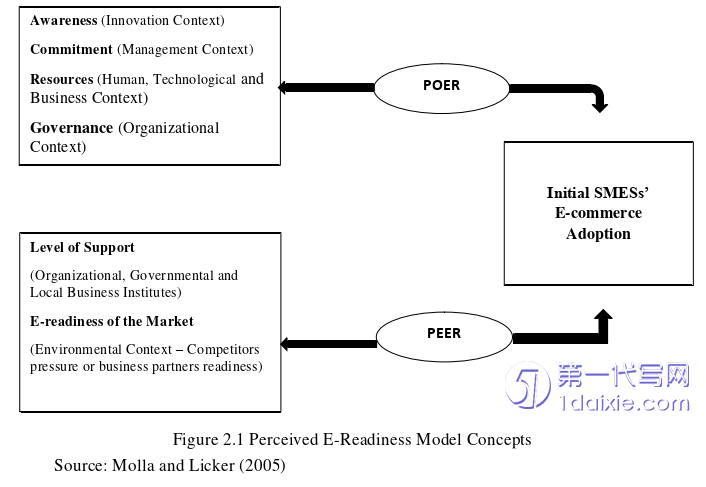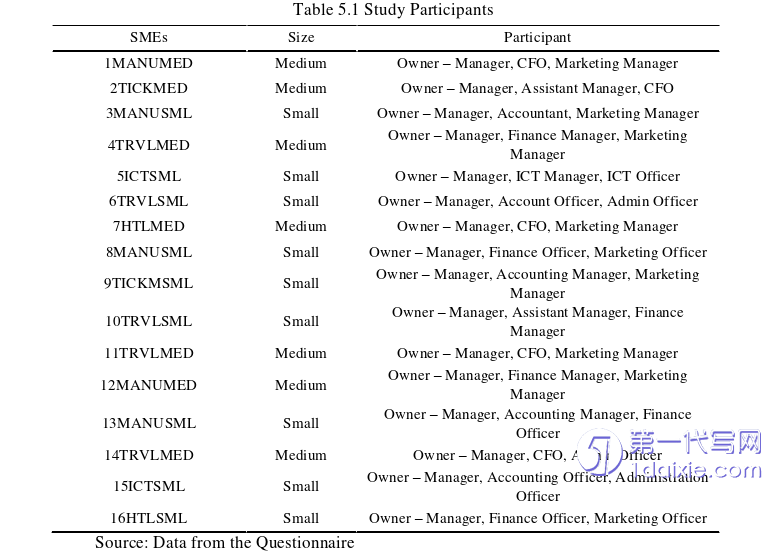本文是一篇电子商务论文,本研究建议组织需要非常重视这三个因素需要仔细并在可能的情况下制定有效的战略,以克服他们面临的挑战。
1 INTRODUCTION
1.1 Research Background and Significance

Most countries adopted the changes in global business for economic growth and prosperity. In the 2000s Information and communication technology play essential roles in different countries. This technological change impacts commercial and nonprofit organizations Aboobucker I (2019). The way most organizations have been doing business activities, such as transactions and advertising, has been dramatically improved by using electronic devices, systems, and infrastructures. According to AnBiucky et al., (2017), e-commerce is expanding quickly worldwide, affecting every industry and altering how businesses operate. E-commerce's effects are being felt across the board, from large corporations to small and medium-sized enterprises (SMEs). Most SMEs have recognized the benefits of e-commerce and are attempting to adopt this technology, but most have yet to do so for various reasons due to their challenges. To successfully integrate e-commerce, businesses must consider five phases, according to a study by Beyari (2021).
The study discovers that SMEs must first understand those advantages to take to the benefits and opportunities that e-commerce brings to their enterprises. Then, SMEs will create the needed e-commerce capabilities from their views to increase their competence. To properly appreciate the potential of the capacity they seek, SMEs must evaluate the obstacles in their way, claims Domadenik et al., (2018). The activities made to encourage widespread e-commerce may be influenced by perceived barriers. The final step is to determine the benefits of adopting e-commerce Akman (2017).
1.2 Statement of Problem
SMEs have been the most critical influence on economic growth in African countries. According to Nikundiwe E. A. (2022) study, small firms comprise around 40% of all global businesses. The study also noted that SMEs account for roughly 60% of employment rates. The United Republic of Tanzania claims BOT (2020), Small and medium-sized businesses (SMEs) account for around 70% of the country's GDP, 80% of all jobs, and more than 80% of the output of manufactured goods. Notwithstanding SMEs’ impacts on economic growth, stakeholders are concerned about how well SMEs perform and whether they will survive Millita (2020). Almost 60% of small enterprises in Tanzania, according to the OECD (2022) there, fall within the first year of existence.
Poor saving habits, a lack of entrepreneurial abilities, and their inability to take advantage of new growth prospects are just a few of the many variables that have been contributing to the low survival rate business owners need to employ Information and Communication Technology effectively if they want to compete in the global economy. Pereira, C.S et al., (2022) believes that for small enterprises to compete in the market actively, they must adapt to ICT. SMEs and corporate enterprises have experienced a variety of difficulties running their businesses. E-commerce adoption has been one strategy for overcoming this. Most organizations can remain competitive globally and expand their company potential by adopting e-commerce techniques Horga (2021). SMEs must adopt and effectively use e-commerce to acquire a competitive advantage over domestic and international markets Titiyal R. (2022). The SMEs will increase the distribution of their products and company procedures like payments using e-commerce Al-Adwan A. and Sammou G. (2021). According to Nguena C. (2019), E-commerce helps SMEs communicate better with their clients and suppliers and facilitates more effective promotion.
2 LITERATURE REVIEW
2.1 Small and Medium Enterprises
Since this idea elaborates on the degree of development that a specific country has reached, there does not appear to be a definition of Small and Medium Enterprises that is universally recognized Lone, S. et al., (2021). However, the capital employed, staff size, and sales turnover are the criteria that are most typically used to categorize micro and small businesses Mero (2022). Even the style of administration is occasionally employed Veniard C. (2021).
According to Saáry R. and Kárpáti-Daróczi J. (2022), SMEs are often referred to as micro, small, and medium enterprises because the word "SMEs" is used to denote these businesses (MSMEs). Small and medium-sized enterprises (SMEs) include non-farming economic activities like mining, service industries, manufacturing, and retail. According to Lone S et al., (2021), businesses are classified as micro and small in the Japanese context based on their primary activity, the amount of money they have used, and the number of employees. For instance, the amount of capital employed in the retail and service industries is typically up to 10 million Yen, with a cap of 50 employees.
In the context of Tanzania, a micro-enterprise is defined as an organization that employs up to four employees, most of whom are family members, and that invests less than TZS 5 million in the capital Ulimboka L. et al., (2020). The informal sector is where the majority of micro-businesses are located. Small businesses are often formal operations employing 5 to 49 people or having an investment capital between TZS 5 million and TZS 200 million Noor A et al., (2018). On the contrary, medium-sized businesses typically have between 50 and 99 employees or an initial capitalization of between TZS 200 million and TZS 800 million.
2.2 E-commerce
According to Esaku S (2020), online communications networks connect business players in e-commerce, defined as the exchange and interaction between informatics and the use of computer technology in conducting commercial activity (suppliers and customers normally). The implementation of E-Commerce networks and systems, whether the World wide web or built on other related mechanisms, has completely altered how businesses and organizations interact with their clients and conduct business.
According to Aboobucker I. (2019) e-commerce, encompasses all related events that are meant to promote sales and do not just refer to selling and buying through electronic channels. These activities can range from gathering product-related information to actually selling and acquiring products and services. Any value exchanges including the transmission of data, the delivery of goods and services, or the processing of payments over electronic networks are referred to as electronic commerce. By employing technology to alter how items are created, advertised, and delivered, e-commerce companies change their goods, processes, and business strategies Nir Vulkan (2020). Digital marketing, electronic funds transfers, internet payment processing, management of supply chains, electronic data exchange (EDI), management of stocks, and automated data gathering systems are just a few examples of the technology that is heavily used in e-commerce. In general, the term "electronic" denotes a medium or platform that makes use of information and communication technologies (ICTs).
3 E-COMMERCE AND SMEs IN TANZANIA ................................ 20
3.1 Definition of SMEs ........................................ 20
3.2 Current status of the SMEs in Tanzania ............................. 20
3.3 E-commerce Market in Tanzania ........................... 22
4 RESEARCH METHODOLOGY .................................... 25
4.1 Research Paradigm and Philosophy ....................................... 25
4.2 Research Design ........................................ 25
5 DATA ANALYSIS AND DISCUSSION OF FINDINGS ............................... 34
5.1 Respondent Information ........................ 34
5.2 Characteristics of the Respondents ............................. 35
5 DATA ANALYSIS AND DISCUSSION OF FINDINGS
5.1 Respondent Information
This chapter presents and evaluates SME adoption for e-commerce. The analyzed data was gathered to assess the elements influencing SMEs' adoption of e-commerce in Tanzania. Sixteen SME businesses in the manufacturing, hotel, tourist, and IT industries were the focus of the study. The study primarily looks at the financial aspects of SMEs, the technological elements, and the legal factors that influence SMEs' adoption of e-commerce.
Also, the study discusses the sub-themes within a topic that are related to financial, technical, and legal (factors affecting e-commerce adoption). The concepts from Hernando C (2019) and Alawi and Al-Ali (2018), as well as the researcher's skill and creativity Goyal S (2021), have been used to add more context to the texts, photos, and handwritten notes gathered during participant interactions in the interview phases.

6 CONCLUSION AND RECOMMENDATIONS
6.1 Summary of the Findings
The study examines the variables influencing SMEs' adoption of e-commerce in Tanzania, the respondents were selected from 8 SMEs located in Dar es Salaam. The study examines the level of SMEs’ financial factors, SMEs’ technical aspects and SMEs’ legal factors’ effect on the adoption of E-commerce.
The analysis proved that there is a strong positive relationship between SMEs’ financial factors and the adoption of E-Commerce hence the R-value of .965 is near 1.
And also, the finding revealed that factors including shoestring budget, maintaining cost, purchase price, internet availability and online product price all have a positive impact on SMEs’ decision to adopt e-commerce.
The regression analysis has been done to test the relationship between dependent and independent variables resulting in an increase of 1% of a shoestring budget, maintaining cost, purchase price, internet availability and online product price will lead to an increase in the adoption of e-commerce 0.018 + 0.065 + 0.233 + 0.014 + 0.535 + 0.075.
Moreover, the study determined that technical know-how, speed of the internet, privacy protection of the clients, and reliability of the power supply have a positive impact on SMEs’ adoption of e-commerce. The study justified the technical aspect as being the biggest challenge facing SMEs when adopting e-commerce. The regression result has been matched to the findings of previous studies.
reference(omitted)
